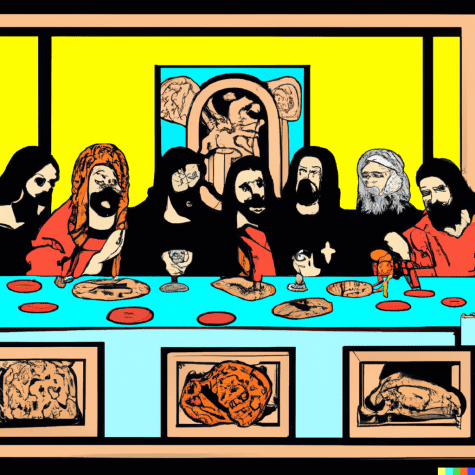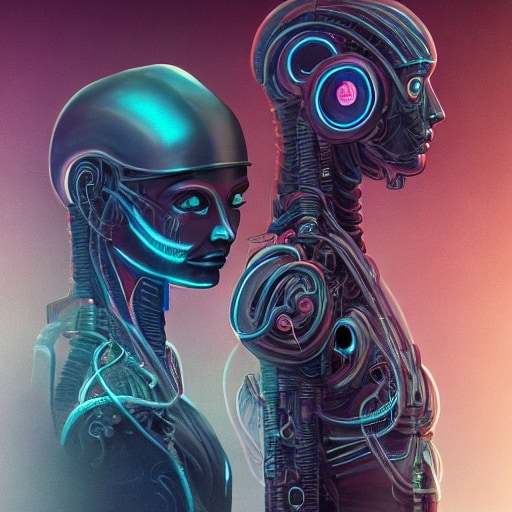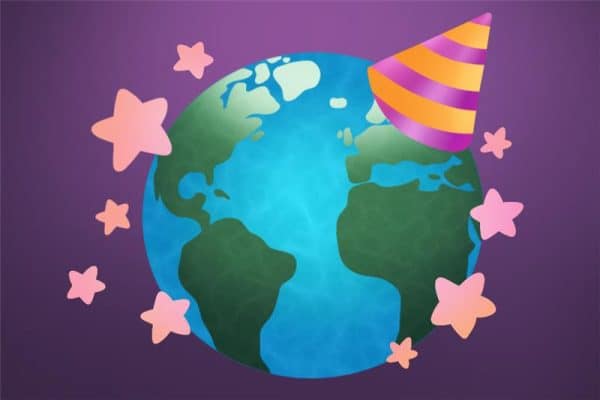UA professors share how to use ethics and responsibility with AI art
April 5, 2023
New technology can be scary, especially if it threatens humans’ jobs. The introduction of new artificial intelligence generators to create graphic designs has led many traditional and digital artists to panic. Through just typing in a prompt, either detailed or vague, one can instantly produce an original image using artificial intelligence.
Programs such as Dall-E 2 are user friendly and readily available. The programs can understand many prompts from “pop art version of the last supper painting” to “playful logo for scrunchie business.”

Depending on which AI art generator is being used, there may be varying levels of pay walls. For example, on Dall-E 2, users can use the program for up to 15 prompts that renew each month. On the other hand, some programs such as Dream by Wombo are free with the option of upgrading under a subscription model.
Like all forms of new technology, there are both benefits and disadvantages. An advantage is that it allows artists and graphic designers to quickly get their ideas on the page.
Jiaqi Gong, an adjunct associate professor of computer science and mechanical engineering, said AI art generators have a generally positive impact with their ability to give freedom to artists through decreased labor time, and their enablement of peoples’ creativity.
“I think the AI generation tools gave some freedom of the art to creators for more freedom to focus their creativity, rather than the labor-intensive process,” Gong said. “It gives ordinary people more enhanced abilities to look at their creative path, rather than always starting from scratch. You follow the patterns and then during the learning process, the person might already be creative.”
Melissa Yes, an assistant professor for digital media in art, said that a positive benefit from using AI art generators is the ability to sketch out ideas quickly. Instead of having to labor over thumbnails of images, artists can skip the more traditional art step through inputting key words and ideas into an AI art generator.
“If you’re trying to sketch out an idea, and you just like really need to quickly realize it visually without laboring over a quick sketch, you could ask AI to help you fully flesh out a preliminary image as you’re working through a concept or a design and that can be handy,” Yes said.
For AI art generators specifically, Gong said that the models don’t always automatically come out with a “pretty” image. While a major part of the labor has been taken on by the AI art generators, it still takes an artist or graphic designer with a good eye to discern what their client or they themselves need for a project.
Yes had the opportunity to work with AI art generators and described them as a good writing exercise that allowed her to improve on strategy. Additionally, she said that different strategies will work for different engines.
“AI art is actually a really good creative writing exercise, or somewhere between creative writing and perhaps technical writing because there is an art and an engineering to the way that you craft sentences for the AI to interpret,” she said. “It really became an exercise for me to think, ‘How do I communicate with this have to get help it understand what I’m looking for?’”
Yes said that AI art generators as software reflect the good and bad of society since humans insert their own biases into their work.
“Almost all algorithms are rife with the biases that are built into the system, the biases that are already in our culture, because these systems learn from the way that we speak and the images that we make,” she said. “They basically learn what we’re doing and repeat it back to us.”
Biases in technology can be seen as subtle at first until taken at look at for further inspection.
“A lot of facial recognition software has misidentified people with dark skin and disproportionately and wrongfully put some people in jail or in court more than other people,” Yes said. “So, the same AI eyes that are looking at faces are looking at all other kinds of images and recognizing patterns based on how these images are contextualized.”
Yes said these biases can manifest themselves in many ways, including in sexualizing images of women because of the images that exist for the AI software to draw inspiration from.
“AI software’s basically just looking at what exists and showing it back to us. Any bias or pattern, good or bad that exists in our visual culture is going to end up in these images too,” Yes said.
However, one of the many unknowns that comes with using AI generative models is how to use them ethically and responsibly. Yes described the immediate threat as two-fold. The first is having images of your art on the internet now opens for AI art generators to use them as inspirations or even just plainly use aspects of them. The second issue is a decreased demand for traditional artists and photographers, since generators have the ability to create simple images, graphics, and stock images for free.
She said people should use the power of AI art generators in a moral way. Instead of using AI art generators to directly copy another artist’s work, she encouraged people to instead be more specific in the prompts with how one would like the image to come out. For example, instead of trying to directly mimic what another artist is doing, use more specific keywords.
Yes said that one cannot be critical of AI art generators without seeing the same ideas being reflected in humans.
“When we make an image, it’s always informed by what we’ve already seen in the world,” she said. “So, if we’re going to be critical about AI, how can we also turn that critical lens inward and ask ourselves, ‘How can when we’re borrowing and taking influence from other things? Are we doing that responsibly?’”
Gong said that due to the problems with ethics arising in AI generative models, it would be wise to create ethics courses for individuals who will be using these models in their professional lives.
“You need to carefully examine the content based on your training,” Gong said. “You should have some basic idea, basic concept or basic mindset about ethics to basically establish some self-awareness about ethical issues.”
Because of the newness of AI art technology, several misconceptions surrounding the topic have arisen.
Gong said a misconception of AI art generators is the belief that it doesn’t take a level of skill or expertise to use them. For example, a popular AI model is ChatGPT, which is a great tool to help students study. However, Chat GPT should not be fully relied upon due to chances of inaccuracy.
Yes said that the moral and ethical questions that AI generators raise should also be turned inward to the makers of the programs.
“When we make an image, it’s always informed by what we’ve already seen in the world,” Yes said.
Whether one ends up using AI or not, she said that while AI art generators can seem scary, the human touch and feeling that comes from traditional art will continue to flourish.
“That’s my hope, is that this is going to invite artists to consider what it really means to be a human, who’s making images and how that’s different from being an AI that making images,” Yes said. “My hunch is that the real difference is that when a human makes a work of art, they are putting meaning into it and/or they’re putting feeling into it and they’re putting their actual and human experience into it. No matter what it looks like visually in the end, that is something that an AI is not doing.”











